Have you been suffering from persistent elbow pain and discomfort that interferes with your daily activities? If so, you may be dealing with a condition known as Tennis Elbow, or lateral epicondylitis. This common condition affects the tendons in the outer part of the elbow, causing pain and tenderness that can significantly impact your quality of life. This can make for a difficult time, but you don’t need to face this pain alone.
At the Sydney Orthopaedic Surgeon Clinic, we have the expertise to help you find relief and regain functionality in your elbow. Leading our team is Dr Stuart Kirkham, a trusted and highly skilled orthopaedic surgeon with over 25 years of experience. Dr Kirkham is dedicated to providing exceptional care to his patients, and his expertise in treating Tennis Elbow has made a positive difference in the lives of numerous individuals.
With his extensive knowledge and compassionate approach, Dr Kirkham is committed to understanding your unique situation and finding the best possible solution to alleviate your pain and restore your elbow function. From non-surgical approaches such as rest, physiotherapy, medications, and injections to advanced surgical interventions, Dr Kirkham will work closely with you to develop a personalised treatment plan that focuses on your goals and helps you achieve the best possible outcome.
Don’t let Tennis Elbow hold you back any longer. Take the first step towards recovery and schedule a consultation with Dr Kirkham at the Sydney Orthopaedic Surgeon Clinic.
Anatomy
The elbow joint is an important yet complex structure that allows for the bending and straightening of the arm. It is one of only two bone systems that can produce a full 180-degree pivoting turn due entirely to the unique arrangement of tendons and ligaments on the lateral or radial side of the elbow. It is comprised of three bones: the humerus, which is the upper arm bone, and the radius and ulna, which are the forearm bones. These bones come together to form a hinge joint that enables essential everyday movements like gripping, lifting, and throwing.
Tendons are at the heart of the elbow’s functionality are the tendons, and they play a crucial role in transmitting forces from the muscles to the bones. Tendons are tough, fibrous tissues that connect muscles to bones, providing stability and allowing for movement. In the elbow, the tendons work in harmony with the muscles to control the flexion and extension of the joint.
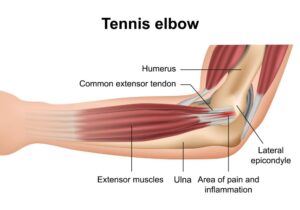
When it comes to Tennis Elbow, the focus is on the specific area of the elbow where the tendons are attached to the bone. This area, known as the lateral epicondyle, is located on the outer part of the elbow. It is here that the tendons responsible for extending the wrist and fingers attach to the bone. The repetitive and excessive use of these tendons, often associated with activities such as racquet sports, repetitive gripping, or heavy lifting, can lead to the development of Tennis Elbow.
The outer part of the elbow, affected by Tennis Elbow, is prone to inflammation and micro-tears due to the strain placed on the tendons. While these tears are typically between 2mm and 10mm, they can result in immense pain, tenderness, and difficulty in performing activities that require gripping or lifting. Understanding the specific anatomical structures involved in Tennis Elbow helps us comprehend why this condition can be debilitating and why seeking timely treatment is crucial.
When it comes to addressing Tennis Elbow and its impact on your daily life, Dr Stuart Kirkham and the team at the Sydney Orthopaedic Surgeon Clinic are here to provide the expertise and guidance you need. With their comprehensive understanding of the elbow’s anatomy and function, they can develop a personalised treatment plan to alleviate your pain and restore functionality, allowing you to regain control of your life.
Causes and Risk Factors
Tennis Elbow, also known as lateral epicondylitis, is primarily caused by repetitive strain and overuse of the tendons in the outer part of the elbow. Activities that involve repeated gripping, twisting motions of the wrist, or excessive force on the forearm muscles can contribute to the development of this condition. For example, avid tennis players who frequently use an improper technique or grip their racquets too tightly may be more susceptible to Tennis Elbow, hence its unique name.
A wide range of risk factors can increase the likelihood of developing Tennis Elbow. Age is a significant factor, as the condition commonly affects individuals between the ages of 30 and 50. Occupational hazards may also play a role in the development of the condition, particularly for those involved in jobs that require repetitive motions or the constant use of gripping and lifting. Plumbers, painters, carpenters, and even office workers who spend extended periods typing on a keyboard can be at risk.
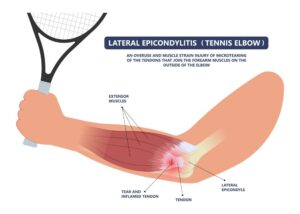
Naturally, certain sports and recreational activities may predispose individuals to Tennis Elbow as well. Besides tennis, sports such as golf, baseball, and cricket which involve repetitive arm movements can put stress on the tendons in the elbow. Additionally, factors like poor conditioning, improper equipment, and inadequate warm-up routines may further increase the risk of developing this condition.
Understanding the causes and risk factors associated with Tennis Elbow is essential in preventing its onset or minimising the impact it has on your life. Dr Kirkham and his team at the Sydney Orthopaedic Surgeon Clinic have great experience identifying these factors and providing individualised guidance to mitigate risks. By addressing the root causes and implementing preventive measures, Dr Kirkham helps patients educate patients about the symptoms and potential complications, ensuring they can continue pursuing their daily activities with minimal disruption.
If you suspect you may be experiencing Tennis Elbow or have concerns about the risk factors, do not hesitate to reach out to Dr Kirkham for a consultation. His expertise and personalised care can help you navigate this condition and find effective solutions to alleviate pain and restore your elbow function.
Symptoms and Identification
Tennis Elbow can inflict a number of symptoms on an individual with the condition, and it’s important to be aware of them for swift identification of the condition. The most prominent symptom an individual may experience is pain in the outer part of the elbow, and this may gradually worsen over time. This pain can range from mild discomfort to a persistent, sharp sensation that intensifies when engaging in activities that require gripping or lifting. In some cases, this pain may be wider reaching and radiate down the forearm.
As time passes and the condition progresses, the symptoms may worsen and become more painful, resulting in the affected arm becoming weaker and therefore making it even more difficult for them to grip objects firmly. Simple actions like picking up a cup of tea, lifting a briefcase or straightening the elbow can all cause significant pain. may become challenging and painful. Without proper management, the condition can lead to significant limitations in daily activities and a decline in overall quality of life.

When it comes to Tennis Elbow, early identification and intervention are key to successful treatment. Self-identification methods can be useful in recognising the symptoms of Tennis Elbow, but it is crucial to seek professional medical advice for an accurate diagnosis. If you experience persistent elbow pain, tenderness, or difficulty with arm movements, it is recommended to consult with Dr Stuart Kirkham at the Sydney Orthopaedic Surgeon Clinic.
His personalised approach, extensive medical knowledge, and tailored treatment plans can help alleviate your symptoms, restore functionality, and improve your overall quality of life. His expertise and experience may also be invaluable in distinguishing Tennis Elbow from other conditions that may present with similar symptoms, ensuring you receive the right treatment for your condition. Take the first step towards recovery by scheduling a consultation with Dr Kirkham and let him guide you on the path to healing.
Diagnosis and Imaging
Diagnosing Tennis Elbow involves a comprehensive process aimed at evaluating the symptoms, understanding the patient’s history, and conducting physical examinations. The diagnostic journey starts with a discussion of the patient’s symptoms and a detailed physical examination of the affected elbow. During this examination, Dr Kirkham will assess the area for tenderness, swelling, and pain response. He may also evaluate the range of motion, grip strength, and muscle function in the affected arm.
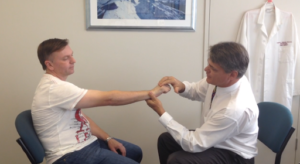
A clear understanding of the patient’s medical history, personal and professional life can also be important in diagnosing Tennis Elbow, as it provides valuable insights into potential causes and risk factors. To gain this insight, Dr Kirkham will inquire about occupational activities, sporting involvement, and any recent changes in physical routines that may have contributed to the development of the condition. Gathering this information helps to establish a clear understanding of the individual’s unique circumstances, and as a result, it is often a vital part step in formulating an accurate diagnosis.
In some cases, a range of imaging techniques may be used to assist in the diagnosis of Tennis Elbow. While X-rays are not able to directly examine soft tissues like tendons, they can help rule out other potential causes of elbow pain, such as fractures or arthritis. MRI (Magnetic Resonance Images) can provide a clear view of the soft tissues around the elbow, including tendons, and they are important in assessing the extent of the damage. Ultrasound is another valuable tool that can be used to visualise the tendons in real-time, allowing for a clear assessment of their condition while helping to identify any abnormalities.
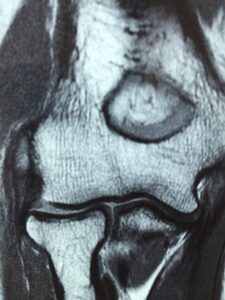
These imaging techniques, combined with a physical examination and an understanding of the patient’s history, are all used to provide an accurate diagnosis of Tennis Elbow. Dr Kirkham has great experience in interpreting the results of these tests and can formulate an appropriate treatment plan in response to the new information. By seeking his specialised care and advice, you’ll gain a thorough understanding of your condition and can begin your journey towards recovery and restored functionality. Don’t hesitate to contact Dr Kirkham to schedule a consultation and take your first steps towards a diagnosis and effective treatment for your elbow pain.
Treatment Options
When it comes to treating Tennis Elbow, a range of non-surgical and surgical options are available. Non-surgical treatments are often the first line of defence, and they prove effective in alleviating symptoms for many patients. Rest and avoidance of activities that exacerbate the condition are central to this, as it provides the affected elbow time to heal. Physiotherapy and hand therapy are also beneficial, as they can help strengthen the muscles and tendons, improve flexibility, and promote healing.
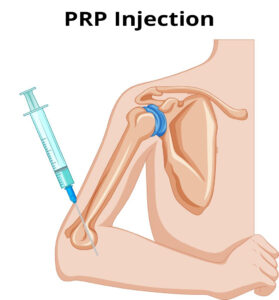
Additionally, Dr Kirkham often recommends splinting or bracing of the affected elbow to provide support and reduce strain on the tendons. Medications, such as non-steroidal anti-inflammatory drugs (NSAIDs), can also help manage pain and reduce inflammation of the area, a common symptom of Tennis Elbow. In some cases, biological injections, such as platelet-rich plasma (PRP) or autologous blood injections, may be considered to stimulate healing and reduce pain.
Surgical intervention for Tennis Elbow is typically reserved for cases where non-surgical treatments have been unsuccessful or if the condition is severe and significantly affects the patient’s daily activities. The specific type of surgery Dr Kirkham performs will depend on the individual’s unique situation. Common surgical procedures include arthroscopic debridement, where damaged tissue is removed using a small camera and specialised instruments, and open surgery, which involves making an incision to access and repair the affected tendons.
The choice of surgery will be determined based on the extent of the injury, the patient’s overall health, and the recommendations of Dr Kirkam. His years of experience and extensive research have resulted in the creation of an innovative new surgical procedure, seeing Dr Kirkham patent a novel implant for tennis elbow. However, this new surgical treatment is currently undergoing research and is not yet available for clinical use.
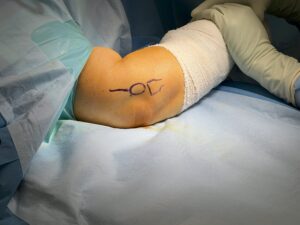
Regardless, Dr Kirkham is well-versed in a range of surgical and non-surgical procedures for Tennis Elbow. Following a careful assessment of the patient’s conditions, symptoms and goals, Dr Kirkham guides patients in selecting the most appropriate treatment approach for their needs, whether it is non-surgical or surgical. He will explain the potential benefits, risks, and expected outcomes of each treatment option, allowing patients to make informed decisions about their care. Throughout the treatment process, Dr Kirkham will closely monitor the patient’s progress, adjust the treatment plan as needed, and provide ongoing support and guidance. With his expertise and commitment, Dr Kirkham’s patients expect to eliminate their pain and enjoy restored functionality and improved quality of life.
Prevention and Aftercare
Preventing Tennis Elbow is possible with a few proactive measures. First and foremost, it is important to use appropriate techniques and body mechanics when you take part in activities that involve repetitive arm movements or gripping. This includes using the proper form relevant to the sporting activity, avoiding excessive force or strain on the tendons, and maintaining a balanced workload.
Taking regular breaks during repetitive tasks also allows the tendons to rest and recover, and therefore reduces the risk of overuse injuries. Additionally, you might wish to incorporate strengthening exercises into your routine, as this can improve the strength and flexibility of the muscles and tendons in the forearm, helping them provide better support to the elbow joint.

After undergoing treatment for Tennis Elbow, a comprehensive aftercare plan is crucial in ensuring a smooth recovery is experienced and preventing future injuries. Physical therapy is crucial to the rehabilitation process as it works towards restoring strength, flexibility, and an improved range of motion. This may include exercises targeting the muscles and tendons of the forearm, as well as stretching and mobility exercises for the entire arm.
In addition to professional therapy, home care practices are essential. Specific exercises may be prescribed by a physiotherapist, but this generally includes practising proper ergonomics and body mechanics during daily activities, and adhering to a phased return to regular activities and sports as advised.
Follow-up appointments with Dr Kirkham are an integral part of the aftercare process, as they allow for close monitoring of the healing progress, assessment of the treatment’s effectiveness, and adjustments to the treatment plan if necessary. Dr Kirkham will provide guidance and support during these follow-up visits, ensuring the patient’s recovery is on track while also addressing any concerns or questions that may arise.

By implementing these preventive measures and adhering to a comprehensive aftercare plan, individuals can minimise the risk of future Tennis Elbow occurrences and optimise their recovery. Dr Kirkham is dedicated to providing guidance and support throughout the prevention and aftercare process, helping all of his patients enjoy a healthy and pain-free lifestyle.
The Recovery Process
The recovery process for Tennis Elbow varies based on the treatment approach the individual experienced. For non-surgical treatments, the recovery timeline typically spans several weeks to a few months. During this time, patients may gradually experience a reduction in pain and an improvement in their ability to perform everyday activities. However, it is important to note that individual recovery timelines can vary based on the severity of the condition, adherence to treatment recommendations, and the body’s natural healing response.
However, surgical treatments for Tennis Elbow may require a longer recovery period. The initial phase of recovery after surgery focuses on pain management, minimising swelling, and wound healing. Patients will likely require a period of immobilisation of the affected arm to allow the surgical site to heal properly. Over the following weeks and months, physical therapy and rehabilitation will be incorporated to restore strength, range of motion, and functionality gradually. The complete recovery timeline for surgical treatments can range from several months to a year, depending on the individual’s healing process and rehabilitation progress.
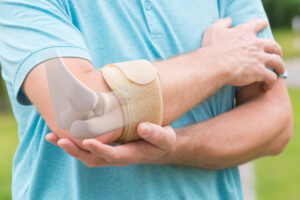
It’s important to note that these timelines can differ between individuals, and there is no one linear recovery path to follow. The recovery timeline can also depend on the severity of the condition, the patient’s overall health, their age, and any underlying medical conditions.
Coping strategies and resources can play a significant role in facilitating a better recovery. Regular physical therapy sessions, adherence to prescribed exercises and a gradual return to activities and sports can all contribute to a smoother recovery. Patients may also find it helpful to learn more about the condition to bolster their knowledge and work towards achieving the best possible recovery outcome.
Throughout the recovery process, Dr Kirkham and the team at the Sydney Orthopaedic Surgeon Clinic are dedicated to providing ongoing support and guidance. Their expertise, along with patient commitment and perseverance, can help individuals overcome Tennis Elbow and regain optimal elbow function.
Possible Complications
While Tennis Elbow is generally a manageable condition, there are potential complications that can arise if left untreated or if treatments are not effectively implemented. One common complication is the development of chronic pain. If the underlying causes and contributing factors are not addressed, the pain associated with Tennis Elbow can persist and become a long-term issue, significantly affecting daily activities and overall quality of life.
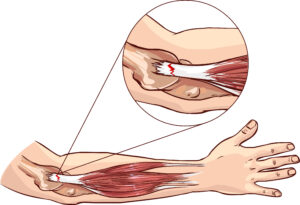
Loss of function is another potential complication of Tennis Elbow. Over time, the continual pain and inflammation in the tendons can lead to weakness and limited mobility in the affected arm. This can severely inhibit the individual’s ability to perform simple everyday tasks, such as lifting objects or grasping items, which can be particularly challenging and frustrating. Without timely intervention and an appropriate course of treatment, the loss of function may become more pronounced.
Complications can also arise from the treatments themselves, particularly in surgical interventions. Although rare, potential risks associated with these surgical procedures include infection, nerve or blood vessel damage, scarring, or limited range of motion. It is important to note that these complications are relatively uncommon, and the benefits of any surgery conducted by Dr Kirkham always far outweigh the risks. It’s also important to note that Dr Kirkham always prioritises patient safety and takes all necessary precautions to minimise the occurrence of complications during surgical procedures.

Timely intervention is of the utmost importance in minimising complications associated with Tennis Elbow. When medical advice and treatment are accessed at the early stages of the condition. Chronic pain and functional limitations can be minimised. Prompt and individualised treatment plans can address the underlying causes of the condition, relieve pain, and promote healing. By taking action early, individuals have a greater chance of achieving favourable outcomes and minimising the risk of long-term complications.
Dr Kirkham’s great expertise and vast experience in treating Tennis Elbow allow for an accurate diagnosis, individualised treatment planning, and proactive monitoring to be undertaken with great success. By seeking his specialised care and guidance, patients can mitigate the risks of complications and improve their chances of a successful recovery.
Are You Concerned About Tennis Elbow?
If you’ve been experiencing persistent elbow pain or discomfort, it is crucial to seek professional medical advice. Tennis Elbow can be a challenging condition to manage, and early intervention is crucial in preventing further complications and ensuring a successful recovery. Don’t ignore the symptoms or dismiss them as temporary discomfort. Seeking medical attention before your symptoms worsen can help medical professionals like Dr Kirkham accurately diagnose the condition and initiate appropriate treatment strategies tailored to your specific needs.

If you’re concerned about Tennis Elbow, don’t hesitate to contact Dr Kirkham for a consultation. His expertise in orthopaedic surgery and vast knowledge of the elbow joint and its many conditions make him an ideal choice for managing and treating Tennis Elbow. In a thorough evaluation, Dr Kirkham can assess your symptoms, review your medical history, and develop a personalised treatment plan to address your condition effectively.
Don’t let Tennis Elbow hinder your daily life any longer. Take control of your recovery and trust Dr Kirkham to deliver the diagnosis and treatment you need to enjoy pain-free days once again.
Frequently Asked Questions
1. What happens if Tennis Elbow is left untreated?
If left untreated, Tennis Elbow can lead to chronic pain and a decline in functionality. The condition may progressively worsen, causing limitations in daily activities and affecting your quality of life. Without appropriate intervention, the pain can become persistent and may even result in a loss of strength and grip. Seeking timely medical advice and implementing appropriate treatments can help prevent these complications and promote a more favourable outcome.
2. Is Tennis Elbow only caused by sports-related activities?
Tennis Elbow is not exclusively caused by sports-related activities. Although sports like tennis, golf, and cricket can heighten the risk, the condition can also arise from repetitive arm movements and gripping in non-sporting tasks. Occupations involving repetitive motions, such as painting, plumbing, or office-related duties, can contribute to the development of Tennis Elbow. Any activity that places strain on the tendons in the elbow region has the potential to lead to this condition. It’s important to acknowledge that Tennis Elbow can impact individuals from diverse backgrounds, irrespective of their participation in sports.
3. How long does the recovery process take for Tennis Elbow?
The recovery process for Tennis Elbow can vary depending on the severity of the condition, the chosen treatment approach, and individual factors. Non-surgical treatments typically involve a recovery timeline of several weeks to a few months. Surgical treatments may require a longer recovery period, ranging from several months to a year. Rehabilitation, including physical therapy, is usually incorporated to restore strength, flexibility, and functionality gradually. It’s important to follow the advice of your healthcare provider and actively participate in the recommended rehabilitation program to optimise your recovery.
4. Can Tennis Elbow reoccur after treatment?
Yes, there is a possibility of Tennis Elbow reoccurring after treatment. Factors such as the severity of the initial injury, adherence to preventive measures, and the nature of the activities performed can contribute to the likelihood of recurrence. To minimise the risk of reoccurrence, it is important to implement proper techniques, take regular breaks, perform strengthening exercises, and avoid overuse or repetitive strain. Maintaining a balanced workload, incorporating appropriate warm-up and cool-down routines, and following the guidance of your healthcare provider can help reduce the chances of Tennis Elbow returning.
5. Can self-care measures alone be sufficient in treating Tennis Elbow?
While self-care measures can play a role in managing Tennis Elbow, they may not always be sufficient. Self-care measures such as rest, ice, and over-the-counter pain medications can help alleviate symptoms, but for more severe or persistent cases of Tennis Elbow, professional treatment may be necessary. A comprehensive treatment approach, which may include physical therapy, splinting, medications, or even surgical options, can provide more targeted and effective relief. It’s important to consult with a healthcare professional, such as Dr Kirkham, who can assess your specific condition and recommend the most appropriate treatment plan for optimal recovery.
References
- Mayo Clinic (Tennis Elbow)
- Ortho Info (Tennis Elbow (Lateral Epicondylitis)
- Health Direct (Tennis Elbow)
- John Hopkins Medicine (Lateral Epicondylitis (Tennis Elbow))


